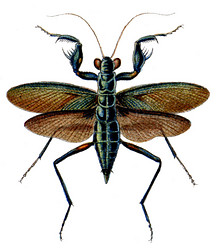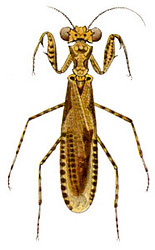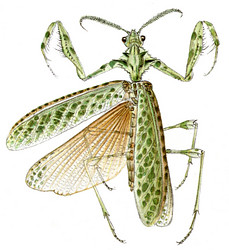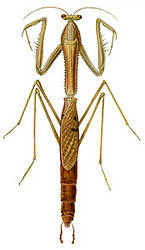Mantodea
Praying mantids and their relatives
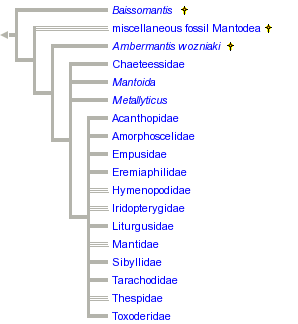


This tree diagram shows the relationships between several groups of organisms.
The root of the current tree connects the organisms featured in this tree to their containing group and the rest of the Tree of Life. The basal branching point in the tree represents the ancestor of the other groups in the tree. This ancestor diversified over time into several descendent subgroups, which are represented as internal nodes and terminal taxa to the right.

You can click on the root to travel down the Tree of Life all the way to the root of all Life, and you can click on the names of descendent subgroups to travel up the Tree of Life all the way to individual species.
For more information on ToL tree formatting, please see Interpreting the Tree or Classification. To learn more about phylogenetic trees, please visit our Phylogenetic Biology pages.
close boxCharacteristics
Derived features:- raptorial forelegs
- ultrasound "ear" on metathorax
- forewings leathery
- male genitalia asymmetrical
- eggs in foamy ootheca
Discussion of Phylogenetic Relationships
The most commonly followed classification of Mantodea is that of Beier (1964, 1968), who divided the group into eight families. Chaeteessidae and Metallyticidae have traditionally been considered to have diverged early from the remaining Mantodea (Klass 1997, Roy 1999):
============ Chaeteessidae
|
|=========== Metallyticidae
|
===| ====== Mantoididae
| |
| |===== Amorphoscelidae
| |
| |===== Eremiaphilidae
======|
|===== Hymenopodidae
|
|===== Mantidae
|
====== Empusidae
In a study of external male genitalia in select mantodean and blattarian taxa, Mantoida was the sister group of the remaining Mantodea, with first Chaeteessidae and then Metallyticidae diverging later (Klass 1997):
========= Mantoida (Mantoididae)
===|
| ====== Chaeteessa (Chaeteessidae)
===|
| === Metallyticus (Metallyticidae)
===|
=== Sphodromantis (Mantidae)
Grimaldi (2003) performed a phylogenetic analysis of many fossil and extant mantids. This analysis suggested a basal grade of fossil taxa, with Baissomantis as sister to Mantodea sensu stricto. Ambermantis and all extant mantids (Eumantodea) formed a clade (Neomantodea). Chaeteessidae was sister to all other extant mantids. (In the phylogeny below, * denotes a fossil taxon.)
===================== Baissomantidae*
|
===| ================== (paraphyletic grade of fossil taxa)*
| |
===| =============== Ambermantidae*
| |
===| ============ Chaeteessidae
| |
| | ========= Mantoididae
===| |
| |======== Metallyticidae
| |
===| ====== Amorphoscelidae
| |
| |===== Eremiaphilidae
===|
| === Empusidae
| |
===|== Hymenopodidae
|
=== Mantidae
Ehrmann (2002) revised the classification of Mantodea, recognizing several new families and subfamilies, and many new genera. Svenson and Whiting's (2004) molecular phylogenetic analysis revealed the paraphyly of several of these families, subfamilies, and genera.
References
Balderson, J. 1984. Catalogue of Australian Mantodea. CSIRO Technical Paper No. 23.
Balderson, J. and K. H. L. Key. 1991. Mantodea (Praying mantids). Pages 348-356 in Insects of Australia: A Textbook for Students and Research Workers. Volume I. Second Edition. I. D. Naumann, P. B. Carne, J. F. Lawrence, E. S. Nielsen, J. P. Spradberry, R. W. Taylor, M. J. Whitten and M. J. Littlejohn eds. Carlton, Victoria, Melbourne University Press.
Beier, M. 1964. Blattopteroidea Mantodea. Pages 829-970 in Bronn's Klassen und Ordnungen des Tierreichs 5.
Beier, M. 1968. 12. Ordnung Mantodea (Fangheuschrecken). Pages 1-47 in Handbuch der Zoologie 4(2) 2/12. J.-G. Helmcke, D. Starck, and H. Wermuth, eds. de Gruyter, Berlin.
Ehrmann, R. 2002. Mantodea: Gottesanbeterinnen der Welt. Natur und Tier, Münster.
Grimaldi, D. 2003. A revision of Cretaceous mantises and their relationships, including new taxa (Insecta: Dictyoptera: Mantodea). American Museum Novitates 3412:1-47.
Grimaldi, D. and M. S. Engel. 2005. Evolution of the Insects. Cambridge University Press.
Kaltenback, A. P. 1996. Unterlagen für eine Monographie der Mantodea des südlichen Afrika: 1. Artenbestand, geographische Verbreitung und Ausbreitungsgrenzen (Insecta: Mantodea). Annalen des Naturhistorischen Museums in Wien 98B:193-346.
Kaltenback, A. P. 1998. Unterlagen fur eine Monographie der Mantodea (Insecta) des südlichen Afrika: 2. Bestimmungstabellen für die höheren Taxa, Nachträge zum Artenbestand. Annalen des Naturhistorischen Museums in Wien 100B:19-59.
Klass, K. D. 1997. The external male genitalia and the phylogeny of Blattaria and Mantodea. Bonner zoologische Monographien 42:1-341.
Lombardo, F. 1997. New and little known Mantodea from eastern and central southern Africa. Journal of Orthoptera Research 6:69-81.
Lombardo, F. and B. Agabiti. 2001. The mantids from Ecuador, with some biogeographic considerations. Journal of Orthoptera Research 10(1):89-104.
Maes, J.-M. and R. Roy. 1999. Orden Mantodea. In Maes, J.-M., Insectos de Nicaragua vol. I., Setab, Bosawas, Marena, Managna: 60-63, 2 fig.
Marshall, J. A. 1975. A catalogue of the primary types of Mantodea (Dictyoptera) in the British Museum (Natural History). Bulletin of the British Museum (Natural History). Entomology, 31 (8):309-329.
Mukherjee, T. K., A. K. Hazra, and A. K. Ghosh. 1995. The mantid fauna of India (Insecta: Mantodea). Oriental-Insects 29:185-358.
Preston-Mafham, K. 1990. Grasshoppers and Mantids of the World. Blandford, London. 192 pp.
Prete, F. R., H. Wells, P. H. Wells, and L. E. Hurd, eds. 1999. The Praying Mantids. Johns Hopkins University Press, Baltimore, London.
Ramsey, G. W. 1990. Mantodea (Insecta): with a review of aspects of functional morphology and biology. Fauna of New Zealand 19:1-96.
Roy, R. 1987. General observations on the systematics of Mantodea. Pages 483-488 in Evolutionary Biology of Orthopteroid Insect. B. Baccetti), ed. Halsted Press (John Wiley & Sons), New York.
Roy, R. 1999. Morphology and taxonomy. Pages 19-40 in The Praying Mantids. F. R. Prete, H. Wells, P. H. Wells, and L. E. Hurd, eds. Johns Hopkins University Press, Baltimore, London.
Svenson, G.J. and M.F. Whiting. 2004. Phylogeny of Mantodea based on molecular data: evolution of a charismatic predator. Systematic Entomology 29(3): 342-352.
Terra, P. S. 1995. Systematics of the Neotropical genera of praying mantis (Mantodea). Revista Brasileira de Entomologia 39(1):13-94.
Tindale, N. B. 1923. Review of Australian Mantidae. Records of the South Australian Museum 2:425-457.
Vrsansky, P. 2002. Origin and the early evolution of mantises. AMBA Projekty 6(1):1-16.
Wang, T. 1993. Synopsis on the Classification of Mantodea from China. Shanghai Scientific and Technological, Literature Publishing House, Shanghai.
Information on the Internet
- The Praying Mantises (Mantodea) of South Africa. Compiled by Alfred P. Kaltenbach, Naturhistorisches Museum in Wien.
- Checklist of the Mantodea. Los Angeles County Museum.
- Key to Preying Mantises. David Oliveira.
- Praying Mantids. CSIRO.
- Gottesanbetterinnen. Staatliches Museum für Naturkunde Karlsruhe. Mantodea collection curated by Reinhard Ehrmann.
- Key to the Mantid Species of Florida (PDF). University of Florida.
- Visual Prey Recognition in Mantodea. Cornell University.
- Bugs in Cyberspace (Mantodea).
Title Illustrations
| Scientific Name | Metallyticus splendidus |
|---|---|
| Reference | E. Giglio-Tos. 1921. Orthoptera. Fam. Mantidae. Subfam. Eremiaphilinae. Genera Insectorum de P. Wytsman 177:1-36 |
| Sex | Female |
| Scientific Name | Metoxypilus |
|---|---|
| Reference | E. Giglio-Tos. 1913. Orthoptera. Fam. Mantidae. Subfam. Perlamantinae. Genera Insectorum de P. Wytsman 144:1-13 |
| Sex | Male |
| Scientific Name | Blepharopsis mendica |
|---|---|
| Reference | M. Beier. 1934. Mantodea. Fam. Mantidae. Subfam. Sibyllinae and Empusinae. Genera Insectorum de P. Wytsman 197:1-10 |
| Sex | Male |





